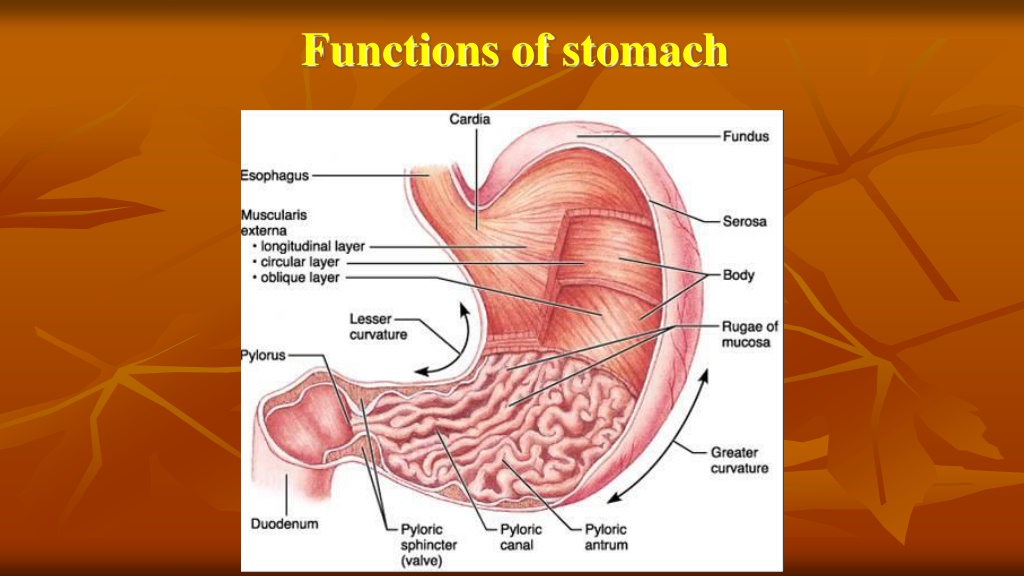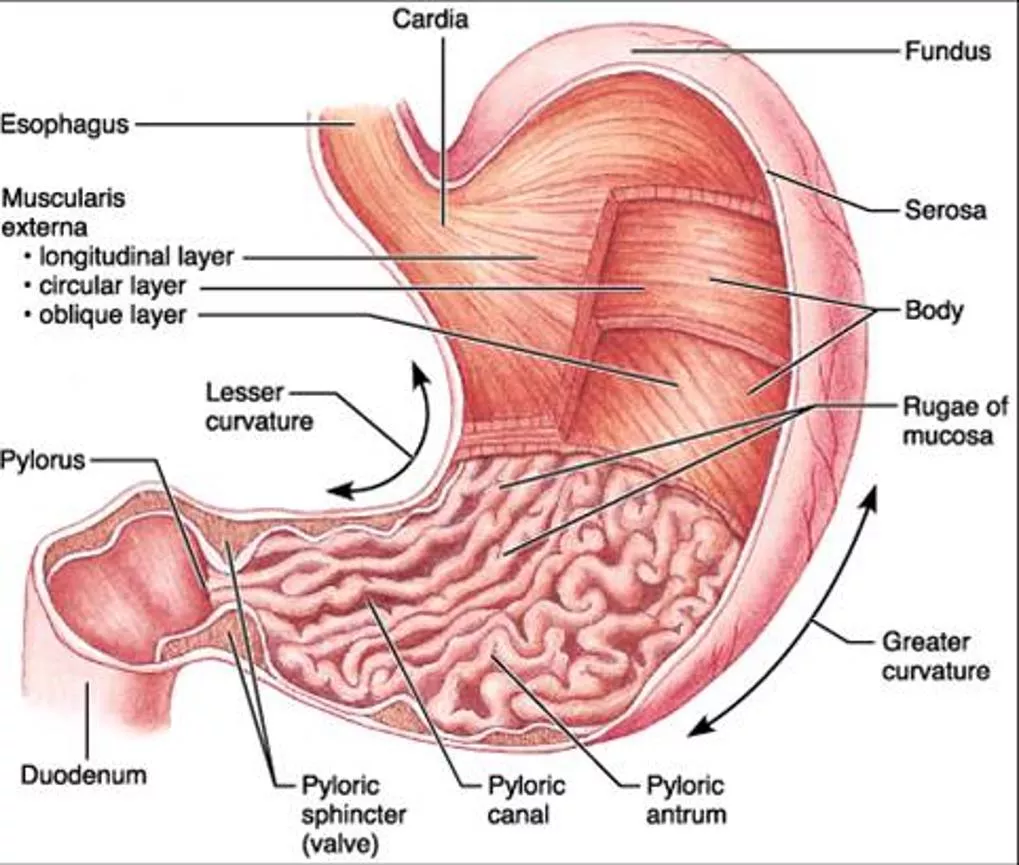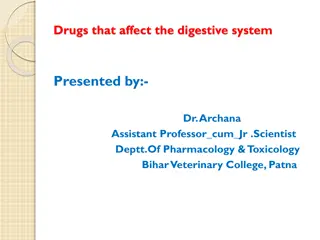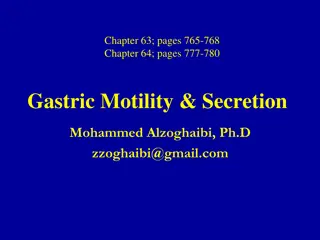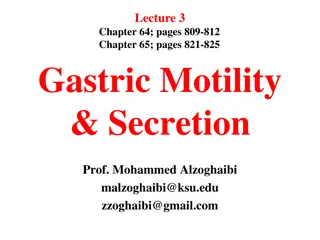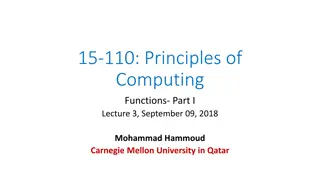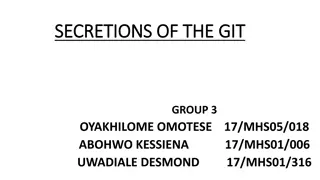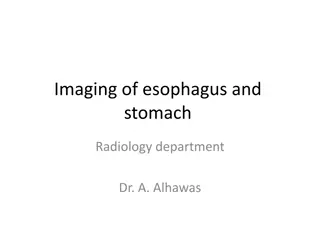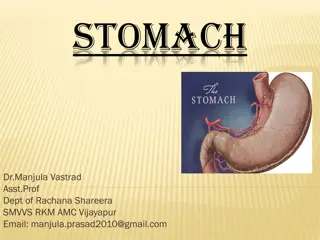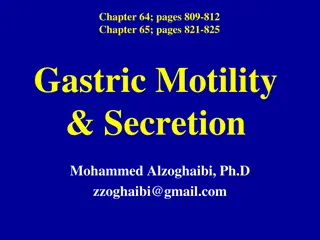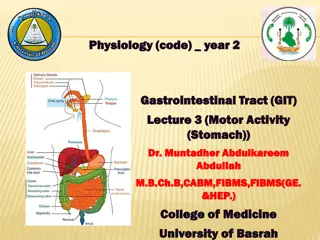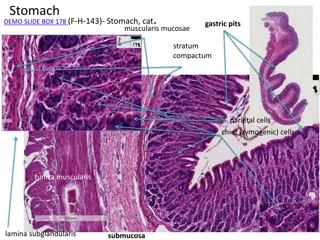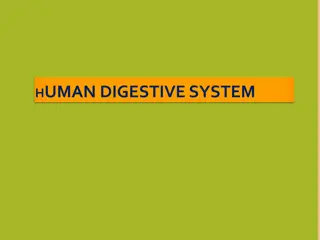Functions and Secretions of the Stomach
The stomach plays crucial roles in digestion through its secretions such as stomach juice, hydrochloric acid, and mucus. These secretions aid in breaking down food components, promoting optimal enzymatic activity, and providing a protective barrier against bacteria. The stomach juice is composed of enzymes, HCl, and mucin, produced by oxyntic and pyloric glands. Hydrochloric acid production involves complex mechanisms that support protein digestion and enhance stomach functions. Understanding the functions and secretions of the stomach is essential for comprehending the digestive process.
Uploaded on Sep 23, 2024 | 1 Views
Download Presentation

Please find below an Image/Link to download the presentation.
The content on the website is provided AS IS for your information and personal use only. It may not be sold, licensed, or shared on other websites without obtaining consent from the author.If you encounter any issues during the download, it is possible that the publisher has removed the file from their server.
You are allowed to download the files provided on this website for personal or commercial use, subject to the condition that they are used lawfully. All files are the property of their respective owners.
The content on the website is provided AS IS for your information and personal use only. It may not be sold, licensed, or shared on other websites without obtaining consent from the author.
E N D
Presentation Transcript
Secretions Production of stomach juice per day near 2,5 L of juice. Their main components enzymes, HCl and mucin. pH of morning saliva is neutral, after eating sour 0,8-1,5. Optimum pH of its activity is 1,5-2,0. Pepsinogens whose activity the most in the condition of pH 3,2-3,5 is gastrecsin. In the stomach, juice produces lipase and gelatinize. HCl produce in parietal or oxyntic cells. pH of its secrete is near 0,8. These processes need energy.
Composition of stomach juice and their properties There are 2 types of glands the oxyntic (or gastric) and the pyloric glands. The oxyntic glands secrete hydrochloric acid, pepsinogen, intrinsic factor, and mucus. The pyloric glands secrete mainly mucus. The main cells (peptic or chief cells) produce non active enzymes (pepsinogens). There are 7 pepsinogens. They hydrolyzed proteins.
Formation of hydrochloric acid Mechanism production: transported canaliculi, Na+ from the canal into cytoplasm. H2O dissociated to H+ and OH-. H+ actively canaliculi in change of K+. In these processes take place Na+,K+-ATPase. CO2, which produce in cells act with H+ and syntheses HCO-. This anion go into the cell in change by Cl-. of its stomach Parietal cell Cl- actively blood in the metabolism carboanhydrase go into se
Role of the hydrochloric acid in the digestion 1. To promote the swell of protein; 2. To promote the change of pepsinogen in pepsins; 3. To make optimal conditions for actions of pepsins; 4. To fulfill protective role from bacteria; 5. To promote motor and evacuated functions of stomach; 6. To stimulate production of duodinum gormon secretin.
Phases of stomach secretion Cephalic Phase Smell, See, Thinking Stomach phase is depends on the quantity of food, which are present in stomach. It has vago-vagal reflexes (by mean of central nerves system) and local peripheral reflexes, which are closed in stomach walls. Duration of these phase is longer and quantity of juice is much. It has humoral mechanisms too (production of gastrin and histamin. Intestine phase: presence of food in the upper portion of small intestine can cause the stomach to secrete small amount of gastric juice. This probably results of gastrin are also released by the duodenal mucosa in response to distension or chemical stimuli of the same type as those that stimulate the stomach gastrin mechanism.
